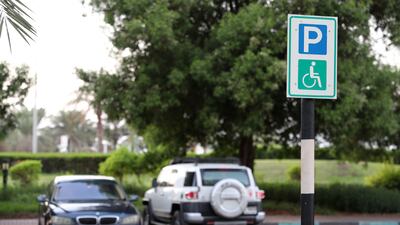Hotels, tourism centres and transport systems must work together to position Dubai and the UAE as accessible travel destinations, disabled access advocates have said.
Detailed information showing hotel room dimensions, tourist landmarks and beach accessibility should be available online, so wheelchair users can make informed decisions about where they want to go, they said at the Future Accessibility summit that began in Dubai on Sunday.
Officials said that, in addition to a unified federal public works approach, specific government departments are being charged with ensuring inclusion in different sectors by 2020.
“Instructions have recently been issued to authorities to start their own strategy in how to retrofit and what goals they need to reach by 2020,” said Hussein Maseeh, an expert in social care and development with the Community Development Authority.
“Already work has started with different authorities to reach their mandate. For example, the Islamic Affairs [department] with mosques, Dubai Municipality with buildings, the health authority would oversee rehabilitation, the Knowledge and Human Development Authority would handle inclusive education.
“The most important is the awareness and realisation that there is a need for change, that the point of view needs to change so that we do not repeat mistakes from the past and innovate in the future.”
Training was being conducted so engineers, architects and students in urban planning fields understand the overall strategy leading to 2020.
The Dubai Universal Design Code states that new buildings and transportation systems must be designed, constructed and managed to enable people with disabilities to independently use facilities.
Older schools, hospitals, hotels and public areas such as parks will be retrofitted over the next three years to ensure access for all.
Mr Maseeh said it was hoped all emirates would adopt the code.
“There is some acceptance of the idea of adopting the Dubai code as a UAE code. We are trying to encourage other organisations and other emirates to adopt the new code because it’s been worked on and it's applicable to the UAE environment. We are hopeful because best practices have been adopted and it's inclusive of all buildings and transportation services, so it covers both areas of public domain,” he said.
_____________________
Read more:
Building disabled-accessible facilities makes good business sense, experts say
Wheelchair users call on developers to consult them on access issues
Matching disabled-friendly aspirations takes time
Dubai to retrofit thousands of buildings to improve disabled access
_____________________
In airports with no direct bridge access to planes, boarding ramps would make it easy for all, including elderly in wheelchairs, said Hideto Kijima, president of Japan Accessible Tourism Centre, and himself a wheelchair user.
“Some people think the price of accessibility is too high, it’s not convenient. We need to change accessibility into possibility,” he said.
“Even if people have the same disability, their needs would differ, so common factors must be gathered. Hotels should show photos of accessible rooms so users can choose to use that hotel or not. Bathrooms can have chairs attached to the wall, wider doors to make it simple, a wheelchair sign on the website, and common toilets on the ground floor should be accessible to all.”
He said it was easier for four and five-star hotels because rooms were larger but the aim should be for even two to three-star hotels to become accessible and display details on its website.
While Mr Kijima said Japan had an accessible transport system, normal hotel rooms were small.
“Some existing hotels use two rooms for wheelchair users but that means hotel owners lose business, so each hotel may have only one accessible room. I hope in time each floor has one room, so it becomes easy for us to book,” he said.
Tina Merk, an engineer with Zayed Higher Organisation, spoke of the need to include access in all design elements.
While the visually impaired prefer tactile markings, wheelchair users find this difficult to use, so there was often need to find a compromise, she said.
“I ask you to open your minds to accessibility as a feature of design and not as an awkward add-on inconvenience,” she said.
Fida Al Hammadi, the head of research and the building system section at Dubai Municipality, spoke at the summit of procedures being put in place to ensure compliance in buildings and utilities.
“This also includes a guide and a checklist with illustrations, so it is easy for contractors, consultants and owners to understand what is required, from preferred parking slots to wider entrance and exit points,” she said.


